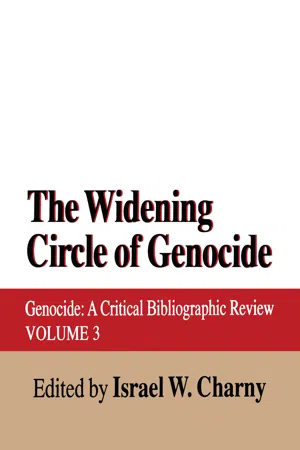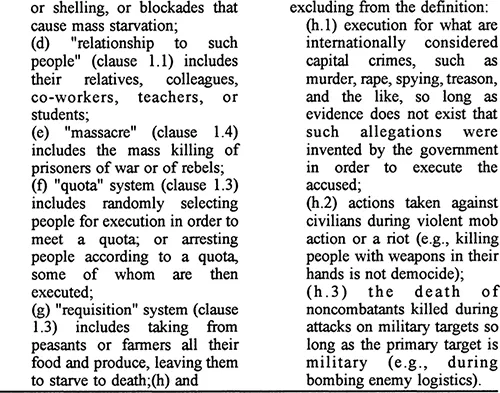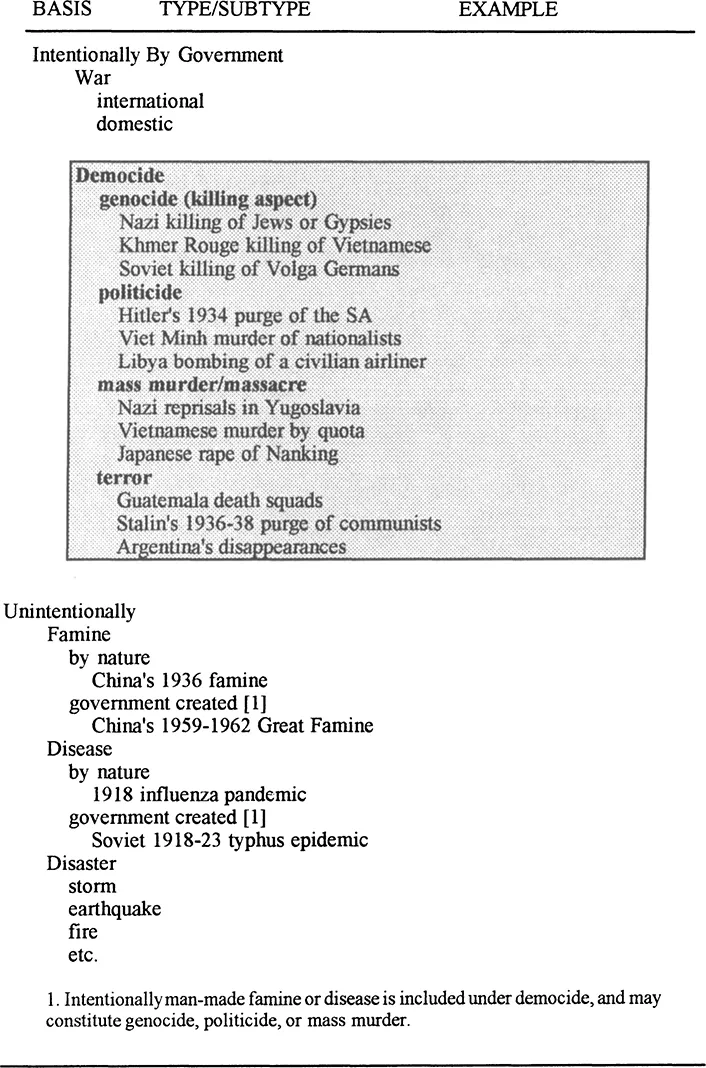R.J. Rummel
The New Concept of Democide
The concept of genocide hardly covers the ruthless murder carried out by totalitarian states. It does not even account for most of those wiped out by the Nazis. A new concept is needed that covers the extent and variety of megamurders by these mortacracies.
In international conventions and the general literature, genocide has been defined as intentional killing by government of people because of their race, religion, ethnicity, or other indelible group membership. While killing people because of their politics or for political reasons has been explicitly excluded from the international Genocide Convention, some scholars nonetheless have included such killing in their study of genocide (Fein, 1984; Kuper, 1981; Porter, 1982). Some have extended the definition of genocide to cover any mass murder by government (Chalk and Jonassohn, 1988; Charny, 1991); some have even stretched it much further to characterize the unintentional spread of disease to indigenous populations during European colonization, including that of the American West (Stannard, 1992).
The problem is becoming conceptually acute. The early generic meaning of genocide was clear, although by its exclusion of political killing, controversial. The present extension of genocide’s meaning, however, creates conceptual confusion and lumps together types of killing that theoretically should be kept distinct. If for example, genocide comes to mean all deaths due to government actions, whether lining up people and machinegunning them, executing prisoners of war, gassing Jews, creating a famine due to bad agricultural policies, the death of children because of ignorant welfare policies, or the accidental creation of fatal disease among subject natives, then we would have to invent a concept to cover the intentional murder of people by virtue of their group identity. Since we already have the concept of genocide for that purpose, we really should create allied concepts to define other types of deaths due to government.
One concept, already suggested in the literature (Harff and Gurr, 1988; Rummel, 1990) is politicide. This defines that killing done intentionally by government for political-ideological purposes, including those killed because of their politics or political views. This is not purely exclusive of genocide, since there are cases, as in the Soviet deportation and murder of ethnic Germans during World War II, that are both genocide and politicide. Generally, however, I have found that this overlap will be but a smaller part of the politicide carried out by mortacracies, even for Nazi Germany. It usually would include, for example, executing purged Communist party members, or murdering anti-communists, counterrevolutionaries, social democrats, dissidents, or critics.
Another concept is mass murder, or government’s intentional and indiscriminate murder of a large number of people. Obviously, in meaning this can overlap with genocide and politicide, but it can also include random executions of civilians, as in the German reprisals against partisan sabotage in Yugoslavia; working prisoners to death, as in the Soviet Kolyma mining camps; the blanket fire bombing of cities, as in the American bombing of Tokyo-Yokohama in 1945 or atomic bombing of Hiroshima and Nagasaki; or atrocities committed by soldiers, as in the 1937 Japanese rape and pillage of Nanking (which probably killed some 200,000 people).
But then there is killing that does not easily fit into any or these categories. There is, for example, murder by quota carried out by the Soviets, Chinese communists, and North Vietnamese. Government (or party) agencies would order subordinate units to kill a certain number of “enemies of the people,” “rightists,” or “tyrants,” and the precise application of the order was left to the units involved. Moreover, millions of people died in labor or concentration camps not because of their social identity or political beliefs, but simply because they got in the way, violated some Draconian rule, did not express sufficient exuberance over the regime, innocently sat on a newspaper with the picture of Stalin showing, or simply was a body that was needed for labor (as the Nazis would grab women innocently walking along a road in Ukraine and deport them to Germany for forced labor). And there are the hundreds of thousands of peasants that slowly died of disease, malnutrition, overwork, and hunger in Cambodia as the Khmer Rouge forced them under penalty of death to labor in the collectivized fields, expropriating virtually their whole harvest and refusing them adequate medical care.
I have covered all this murder as well as genocide and politicide by the concept of democide. Table 1 provides the definition; Table 2 gives an overview of this and the other concepts mentioned above, placing them into the context of other sources of mass death.
Democide is meant to define the killing by states as the concept of murder does individual killing in domestic society. Here intentionality (premeditation) is critical. This also includes practical intentionality. If a government causes deaths through a reckless and depraved indifference to human life, the deaths were as though intended. If through neglect a mother lets her baby die of malnutrition, this is murder. If we imprison a girl in our home, force her to do exhausting work fourteen hours a day, not even minimally feed and clothe her, and watch her gradually die a little each day without helping her, then her inevitable death is not only our fault, but our practical intention. It is murder. Similarly, for example, the Soviet system for forcibly transporting prisoners to labor camps was lethal. In transit hundreds of thousands of political prisoners died at the hands of criminals or guards, or from heat, cold, or inadequate food or water. Although not intended (indeed, this deprived the regime of their labor), the deaths were still murder. They were democide.
The Concept of a Totalitarian State
There is much confusion about what is meant by totalitarian in the literature, including the denial that such systems even exist. I define a totalitarian state as one with a system of government that is unlimited constitutionally or by countervailing powers in society (such as by a church, rural gentry, labor unions, or regional powers); is not held responsible to the public by periodic secret and competitive elections; and employs its unlimited power to control all aspects of society, including the family, religion, education, business, private property, and social relationships. Under Stalin, the Soviet Union was thus totalitarian, as was Mao’s China, Pol Pot’s Cambodia, Hitler’s Germany, and U Ne Win’s Burma.
Totalitariansm is then a political ideology for which a totalitarian government is the agency for realizing its ends. Thus, totalitarianism characterizes such ideologies as state socialism (as in Burma), Marxism-Leninism as in former East Germany, and Nazism. Even revolutionary Moslem Iran since the overthrow of the Shaw in 1978-79 has been totalitarian - here totalitarianism was married to Moslem fundamentalism.
In short, totalitarianism is the ideology of absolute power. State socialism. communism, Nazism, fascism, and Moslem fundamentalism have been some of its recent raiments. Totalitarian governments have been its agency. The state, with its international legal sovereignty and independence, has been its base. As will be pointed out, mortacracy is the result.
Table 1. Definition of democide
Totalitarian governments are the contemporary embodiment of absolute Power1, as classically understood. And Power is a continuum, with limited and responsible Power at one end, and absolute Power - totalitarian governments - at the other end. In the middle are authoritarian governments, that is monarchies or dictatorships that leave social, economic, and cultural affairs and institutions largely free, but squash political opponents or critics (for example, in South Korea and Taiwan until recently, or Thailand and Greece under various military dictatorships). This then gives us a simple summary of relevant findings in the literature. The more unlimited the power of a government, the more likely it will kill. This can be put as a principle:
Power kills, absolute Power kills absolutely.
This Power Principle is the message emerging from research on the causes of war and current, comparative study of democide in this century. The more power a government has, the more it can act arbitrarily according to the whims and desires of the elite, the more it will make war on others and murder its foreign and domestic subjects. The more constrained the power of governments, the more it is diffused, checked and balanced, the less it will aggress on others and commit democide. At the extremes of Power, totalitarian governments have slaughtered their people by the tens of millions, while many democracies can barely bring themselves to execute even serial murderers.
Table 2. Sources of Mass Death
What do we Know about Democracies?
These above assertions about Power are extreme and categorical, but so is the evidence so far accumulated. First consider war. Table 3 shows the occurrence of war between nations since 1816. In no case has there been a war involving violent military action between stable democracies,2 although they have fought, as everyone knows, non-democracies. Most wars are between nondemocracies. Indeed, we have here a general principle that is gaining acceptance among students of international relations and war. That is that democracies don’t make war on each other. To this I would add that the less democratic two states, the more likely that they will fight each other.
Table 3. Wars 1816 - 1991
This belligerence of nondemocracies, that is, authoritarian and totalitarian states, is not an artifact of either a small number of democracies nor of our era. For one thing the number of democracies (“free” states) in 1991 numbered 75 out of 171, or about 44 percent of the world’s states.3 Yet we have had no war among them. Nor is there any threat of war. They create an oasis of peace.
Moreover, this is historically true of democracies as well. If one relaxes the definition of democracy to mean simply the restraint on Power by the participation of middle and lower classes in the determination of power holders and policy making, then there have been many democracies throughout history. And whether considering the classical Greek democracies, democratic forest states of Switzerland, or other historical democratic polities, they did not fight each other (depending on how war and democracy is defined, some might prefer to say that they rarely fought each other). Moreover, once those states that had been mortal enemies, that had frequently gone to war (as have France and Germany in recent centuries), became democratic, war ceased between them. Paradigmatic of this is Western Europe since 1945. The cauldron of our most disastrous wars for many centuries, in 1945 one would find few experts so foolhardy as to predict not only forty-six years of peace, but that at the end of that time there would be a European community with central government institutions, moves toward a joint European military force by France and Germany, and zero expectation of violence between any of these formerly hostile states. Yet such has happened. All because they ar...




